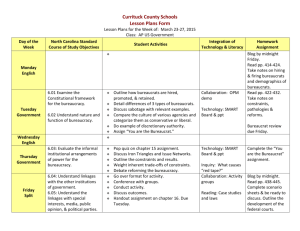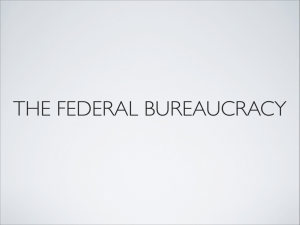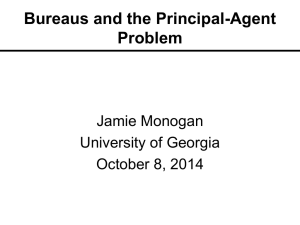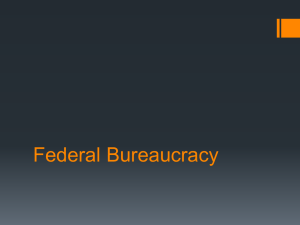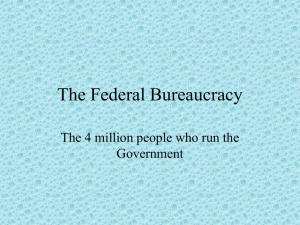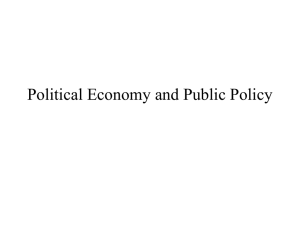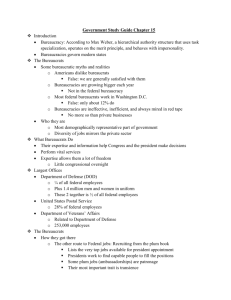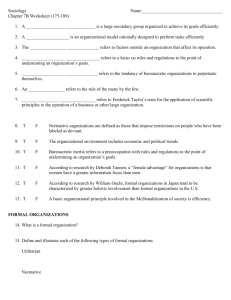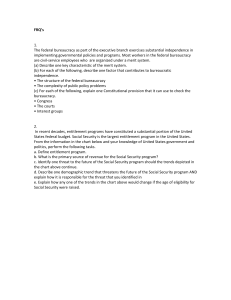Unit 6 Notes (Part II) - Littlemiamischools.org
advertisement
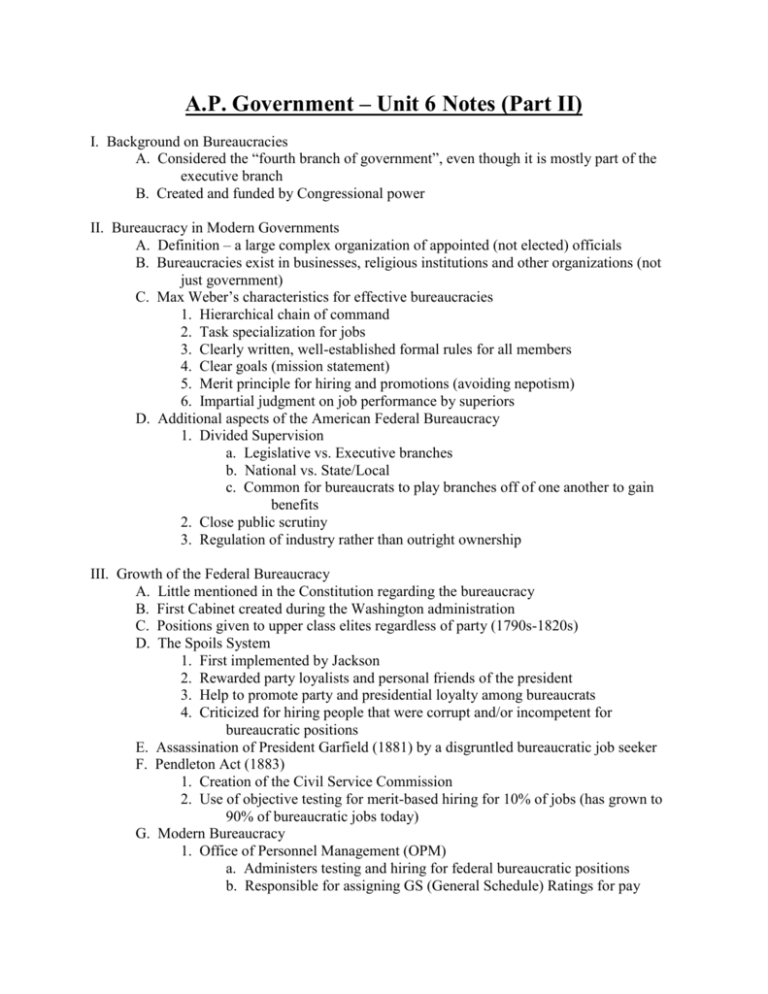
A.P. Government – Unit 6 Notes (Part II) I. Background on Bureaucracies A. Considered the “fourth branch of government”, even though it is mostly part of the executive branch B. Created and funded by Congressional power II. Bureaucracy in Modern Governments A. Definition – a large complex organization of appointed (not elected) officials B. Bureaucracies exist in businesses, religious institutions and other organizations (not just government) C. Max Weber’s characteristics for effective bureaucracies 1. Hierarchical chain of command 2. Task specialization for jobs 3. Clearly written, well-established formal rules for all members 4. Clear goals (mission statement) 5. Merit principle for hiring and promotions (avoiding nepotism) 6. Impartial judgment on job performance by superiors D. Additional aspects of the American Federal Bureaucracy 1. Divided Supervision a. Legislative vs. Executive branches b. National vs. State/Local c. Common for bureaucrats to play branches off of one another to gain benefits 2. Close public scrutiny 3. Regulation of industry rather than outright ownership III. Growth of the Federal Bureaucracy A. Little mentioned in the Constitution regarding the bureaucracy B. First Cabinet created during the Washington administration C. Positions given to upper class elites regardless of party (1790s-1820s) D. The Spoils System 1. First implemented by Jackson 2. Rewarded party loyalists and personal friends of the president 3. Help to promote party and presidential loyalty among bureaucrats 4. Criticized for hiring people that were corrupt and/or incompetent for bureaucratic positions E. Assassination of President Garfield (1881) by a disgruntled bureaucratic job seeker F. Pendleton Act (1883) 1. Creation of the Civil Service Commission 2. Use of objective testing for merit-based hiring for 10% of jobs (has grown to 90% of bureaucratic jobs today) G. Modern Bureaucracy 1. Office of Personnel Management (OPM) a. Administers testing and hiring for federal bureaucratic positions b. Responsible for assigning GS (General Schedule) Ratings for pay 2. Merit Systems Protection Board (hears appeals for possible hiring violations) 3. Hatch Act (1939) a. Attempt to eliminate political corruption among bureaucrats b. Criticized for unreasonably restricting the ability of bureaucrats to participate in the political process c. Reforms in 1993 significantly loosened previous restrictions (ex. bureaucrats can help in campaigns during off hours, but still cannot run for elected office themselves) H. Concerns over a “bloated bureaucracy” 1. Federal bureaucracy massively increased from 1900-1945 in terms of number of jobs as a % of overall job market, but has leveled off since 2. State and local bureaucracies continued to expand until the Great Recession 3. Most people want to cut the size of the bureaucracy, but few agree on what specifically to cut because of varied concerns and constituent needs 4. Devolution – sending more federal responsibilities to state bureaucracies 5. Privatization of programs to operate at a lower cost I. Who are the Bureaucrats? 1. Top 3 employers: a. U.S. Military (all branches) b. Department of Veterans Affairs c. U.S. Post Office 2. Approximately 5 million work for the federal government (2/3 civilian) 3. More diverse ethnically than most private sector industries (1/3 non-white) 4. 90% work OUTSIDE of D.C. 5. Most jobs are white collar (secretaries, lawyers, engineers, etc.) IV. Organization of the Bureaucracy A. Cabinet Departments 1. Heads (secretaries) are appointed by the president and confirmed by the Senate (simple majority) – 15 total 2. Dept. of State (John Kerry) 3. Dept. of the Treasury (Jack Lew) 4. Dept. of Defense (Ashton Carter) 5. Dept. of Justice – Attorney General 6. State, Treasury, Defense & Justice = “Inner Cabinet” (Eric Holder) 7. Dept. of the Interior (Sally Jewell) 8. Dept. of Agriculture (Tom Vilsack) 9. Dept. of Commerce (Penny Pritzker) 10. Dept. of Labor (Thomas Perez) 11. Dept. of Health and Human Service (HHS) (Sylvia Burwell) 12. Dept. of Housing and Urban Affairs (HUD) (Julian Castro) 13. Dept. of Transportation (Anthony Fox) 14. Dept. of Energy (Ernest Moniz) 15. Dept. of Education (Arne Duncan) 16. Dept. of Veterans Affairs (Robert McDonald) 17. Dept. of Homeland Security (Jeh Johnson) B. Director of National Intelligence 1. James Clapper 2. Coordinates 17 different depts. and agencies (FBI, CIA, Homeland Security) C. Independent Regulatory Agencies 1. Responsible for regulating various industries 2. Commission members are chosen similar to Department heads but cannot be removed by the president in the middle of their terms 3. Interstate Commerce Commission (ICC) 4. Federal Trade Commission (FTC) 5. National Labor Relations Board (NLRB) 6. Federal Reserve Board (FRB) 7. Securities and Exchange Commission (SEC) 8. Federal Communications Commission (FCC) D. Government Corporations 1. Corporation for Public Broadcasting 2. Tennessee Valley Authority (TVA) 3. U.S. Postal Service 4. Amtrak E. Independent Executive Agencies 1. Non-regulatory agencies that are similar to departments, but are smaller 2. National Science Foundation (NSF) 3. National Aeronautics and Space Administration (NASA) 4. Central Intelligence Agency (CIA) F. What do Bureaucrats Do? 1. Implementation of laws 2. Use of “discretionary authority” in decision making because most legislation is fairly ambiguous and cannot account for every situation that may come up when implementing 3. Regulation of industries V. Accountability of Bureaucrats A. Congress 1. Duplication of responsibilities 2. Use of authorizations and appropriations for funding (power of the purse) 3. Oversight Hearings 4. Rewriting legislation to be more specific in implementation B. The President 1. Appointments and Firings 2. Executive Orders 3. Budgetary decisions 4. Reorganization of agencies (with Congressional approval) C. The Courts can interpret the limits of bureaucratic power via judicial review VI. Issue Networks A. Groups that have tremendous influence over the implementation of policy B. Bureaucratic agencies, Congressional Committees, interest groups, think tanks, the media VII. Criticisms of the Bureaucracy A. Too much “red tape” B. Conflicting agencies with cross purposes (mostly due to duplication) C. Tradition of “incrementalism” for agency funding D. Waste of funds (largely due to pork barrel legislation) E. Difficulty in attempting to fire incompetent bureaucrats (due to unions and civil service protection) VIII. Suggestions for Bureaucratic Reform A. Terms limits for bureaucrats in specific positions B. Loosen restrictions to more easily fire incompetent bureaucrats C. More interaction with the private sector D. Merit based pay structure as opposed to seniority E. Emphasizing customer service
